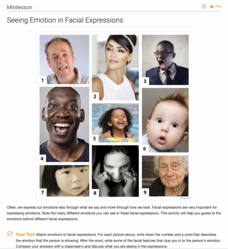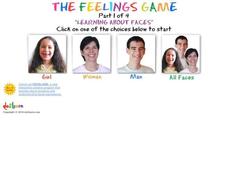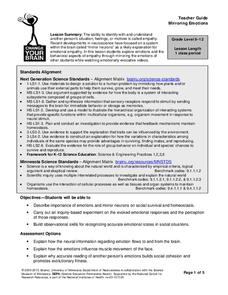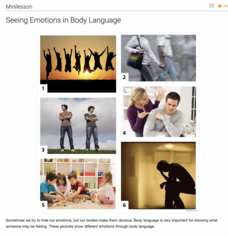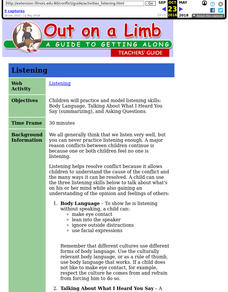Thoughtful Learning
Seeing Emotion in Facial Expressions
Learning to read body language, especially facial expressions, is the focus of a mini-lesson. Young learners examine a series of photographs, identify the emotion being illustrated, and then discuss the cues that revealed the emotion.
Lions Clubs International Foundation
Mindful Self-Awareness Exercise: Identifying Feelings
Following a breathing exercise, scholars examine facial expressions and body posture to identify feelings. The exercise ends with a reflection.
Lions Clubs International Foundation
Mindful Self-Awareness Exercise: Identifying Feelings
Young scholars identify feelings through facial expressions and body language. Learners listen for a feeling word, then act it out and discuss how they portrayed it.
Nemours KidsHealth
Feelings: Grades K-2
Students explore how to appropriately deal with their feelings. In this personal health activity on feelings, students participate in a group discussion about feelings, and complete two activities writing about their feelings and...
Lions Clubs International Foundation
Mindful Self-Awareness Exercise: Identifying Feelings
A self-awareness activity teaches pupils to identify their feelings by focusing on different parts of their bodies. Participants begin by focusing attention on their feet, then calves, moving up slowly to the top of their head, and...
Missouri Department of Elementary
Feeling Faces
A activity help scholars identify emotions through facial expressions. After a friendly puppet reads scholars a poem all about feelings, learners act out how they would feel when a specific action happens to them. Participants watch and...
Health Smart Virginia
How Are You Feeling Today?
A presentation guides a thoughtful discussion about identifying emotions. Slide-by-slide, scholars answer questions and offer details about specific feelings. A worksheet challenges class members to draw facial expressions and...
Learning for Justice
What is Empathy?
Young scholars examine facial expressions to identify emotions, listen carefully to stories, and choose the appropriate reaction. Partners choose one story to rewrite, showing empathy for others.
Kids' Pages
Feelings Matching 1
Even subtle differences in facial expressions can give us a glimpse into how others are feeling. Through this visual matching activity, youngsters work to correctly connect 16 feelings to their appropriate facial expressions.
Northern Ireland Curriculum
Feeling Good, Feeling Sad
Fill your classroom with grand conversations about emotions and the healthy ways to express them. Your scholars will create a collage, play a feelings game, read stories, and reflect on their daily feelings.
Centervention
Halloween Worksheet: Monster Feelings
Monsters have feelings, too! Scholars explore a variety of emotions with a festive, Halloween flair with two dice-rolling activities. The first activity prompts learners to draw and write about a monster feeling a specific emotion. The...
Do2Learn
The Feelings Game
Discerning emotions and intent from facial expressions can be difficult for many learners, particular those with autism spectrum disorder. Help class members practice reading faces with an interactive resource that features three...
International Boys' Schools Coalition
Empathy
Putting yourself in someone else's shoes is a common phrase we hear from time to time, but do children really understand? Explore empathy with elementary schoolers using these activities. Focusing on feelings and emotions,...
Missouri Department of Elementary
Happy, Sad, Scared and Mad: All Belong To Me
"What are feelings?" and "Why are feelings important to understand?" are the essential questions of a lesson plan that boosts self-awareness. Scholars discuss the four basic emotions—happy, sad, scared, and mad—in...
Centervention
Halloween Worksheets: Emotional Monsters
Eight blank monster faces make up an activity that tasks scholars with drawing a face that corresponds to a specific emotion. Feelings include happiness, confusion, silliness, and more.
University of Minnesota
Mirroring Emotions
Do you ever give your class the "teacher look"? Without saying a word, they become silent and engaged (hopefully). How do they know what you're thinking? Explore the concept of nonverbal communication and how it relates to our...
Thoughtful Learning
Seeing Emotions in Body Language
Scholars test their skills of reading body language with a collaborative learning experience that focuses on showing and identifying emotions. Pairs take turns acting out an emotion, one uses body language while the other guesses what...
Amani Project
Harmony Break! Mood Meter Floor Board
The big idea in the fourth lesson from the Amani Project is that people can experience different emotions in precisely the same event. One participant uses their body to express an emotion. Then other participants move to the area of the...
Curated OER
Feathers
First graders examine the character values of kindness, responsibility, and decisions making by playing circle games, listening to a read aloud of the story "Feathers," and discussing the story. They discuss the facial expressions of can...
Centre for Clinical Interventions
Social Skills Treatment Programme
Even though they may not be tested on standardized assessments, social skills are vital for students to develop during their years in school. Through a series of discussions, activities, and role-playing exercises,...
Curated OER
A Guide to Getting Along: Listening
Here is an effective way to have your charges practice and model important listening skills. After a short review of effective active listening concepts, such as using body language, summarizing what the other person said, and asking...
Curated OER
Enhancing Social Skills and Vocabulary through Photography
Pupils in a special education classroom identify pictures of various living things. In groups, they role-play different roles to help them with their social and communication skills. To end the lesson, they take pictures of different...
